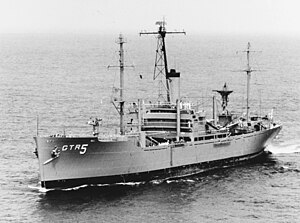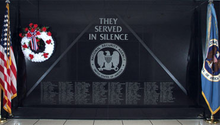USS Liberty
 USS Liberty (AGTR-5) in Chesapeake Bay on 29 July 1967.
| |
| History | |
|---|---|
| Name | SS Simmons Victory |
| Namesake | Simmons College in Boston |
| Owner | War Shipping Administration |
| Operator | Coastwise - Pacific Far East Line (during WW II only) |
| Builder | Oregon Shipbuilding Corp. |
| Laid down | 23 February 1945 |
| Launched | 6 April 1945 |
| Completed | 4 May 1945 |
| Fate | Transferred to US Navy in 1963 |
| Name | USS Liberty |
| Namesake | Localities named "Liberty" in ten US states |
| Acquired | 25 March 1963 |
| Commissioned | 30 December 1964 |
| Decommissioned | 1 June 1968 |
| Out of service | June 1967 |
| Stricken | 1 June 1970 |
| Homeport | Norfolk, Virginia |
| Fate | Damaged beyond economical repair by Israeli attack in June 1967; sold for scrap in 1973 |
| Badge |  |
| General characteristics | |
| Displacement | 7725 tons (light displacement) |
| Length | 139 m (456 ft) |
| Beam | 18.9 m (62 ft) |
| Draft | 7 m (23 ft) |
| Propulsion | Westinghouse steam turbines, single shaft, 8500 horsepower (6.3 MW) |
| Speed | 17.5 knots (32.4 km/h) maximum sustained, 21 knots emergency |
| Range | 12,500 nmi (23,200 km; 14,400 mi) at 12 knots (22 km/h; 14 mph) |
| Complement |
|
| Armament |
|
| Aircraft carried | none |
| Notes | [1][2] |
USS Liberty (AGTR-5) was a
In 1967, Israeli air force and naval units would attack the research ship during the ongoing Six-day war. Israel would later apologize for the attack, stating it had mistaken Liberty for an Egyptian ship, although the reason for the attack has been disputed. USS Liberty would eventually be decommissioned some time after the attack, being sold for scrapping in 1973 due to being damaged beyond feasible repair.
Service history
Early years
The ship was delivered to the War Shipping Administration on 4 May 1945.[2] The next day, she was transferred to the "Coastwise -Pacific Far East Line" and designated as a "Fleet Issue Ship".[2] Her complement included a 17-man Navy Armed Guard detachment to operate the ship's gun battery; a three- or four-man communication liaison detachment; and 16 Navy enlisted people serving as "winchmen and hatchmen".[2]
SS Simmons Victory was tasked with delivering ammunition, which was loaded at the San Francisco-Suisun Bay area navy munitions depot at Port Chicago for Operation Downfall, the planned invasion of Japan.[4] According to Harry Morgan, who served as an engineer on the ship, the Simmons Victory arrived in the Philippines about six weeks before V-E Day on 8 May 1945.[4][a] She made one trip north in support of Operation Downfall and returned to the Philippines.[4][b] She was in Leyte Gulf when Japan surrendered on 15 August 1945.[4]
Simmons Victory departed Leyte Gulf on 6 October 1945, en route to the US West Coast via
From December 1946 until 1963, the ship moved back and forth several times from commercial
| International radio call sign of USS Liberty (AGTR-5)[8] | |||
| November | India | Romeo | Yankee |
In February 1963, the
In February 1965, Liberty steamed from the West Coast to
Israeli attack
On the afternoon of 8 June 1967, while in
The incident has become a subject of controversy and debate, with many books written on the topic.[10]
After the attack, she was escorted to
.Awards and decorations

As a result of the crew's heroic response to the Israeli attack, Liberty is the US Navy's "most highly decorated ship ... for a single action".
Commander (later Captain)
Liberty was also awarded the National Defense Service Medal.[8]
See also
- USS Belmont (AGTR-4), the other ship in her conversion class.
- Technical research ship
- Spy ship
- USS Liberty incident
- List of Victory ships
Further reading
- Ennes, Jr., James M. (1979). Assault on The Liberty. New York: Random House.
References
Explanatory notes
- ^ Morgan says the Simmons Victory took on ammunition just two weeks before the disastrous explosion at Port Chicago on 17 July 1944, an event that occurred months before the ship was launched.
- Sixth Army and the Seventh Fleetwere based in the west Pacific area and both were tasked to participate in Operation Downfall.
- ^ Morgan says, after the war, the Simmons Victory unloaded its cargo of ammunition in Port Chicago. The official Navy account by Cressman seems to indicate that the cargo was dumped at sea: "With a cargo of ammunition, Simmons Victory cleared Leyte Gulf on 6 October 1945, and as part of the preparation for the disarming the vessel, the armed guard dumped the ammo at sea on 8 October." Possibly, only the ammo on deck for the ship's gun battery was dumped at sea and the ammo carried as cargo was returned to Port Chicago.
- ^ Morgan says, after leaving Port Chicago, she took supplies to Baltimore through the Panama Canal.
Sources
- This article incorporates text from the public domain Dictionary of American Naval Fighting Ships. The entry can be found here.
- ^ Babcock & Wilcox (April 1944). "Victory Ships". Marine Engineering and Shipping Review.
- ^ a b c d e f g h i j k l m n Cressman, Robert J. (29 May 2017). "US Navy History, Liberty III (AGTR-5) 1964-1970". United States Navy. Retrieved 13 February 2019.
- ^ Colton, Tim (21 November 2009). "Victory Ships". ShipbuildingHistory.com. The Colton Company. Retrieved 13 February 2019.
- ^ a b c d Gillen, Michael (2015). "Harry A. Morgan: Walnuts and Bauxite for the War". Merchant Marine Survivors of World War II: Oral Histories of Cargo Carrying Under Fire. McFarland & Co. pp. 118, 119, 190.
- ^ ISBN 978-1-4165-5482-0.
- ^ Korean War Educator, Merchant Marine, Accounts of the Korean War
- ^ Small United States and United Nations Warships in the Korean War, By Paul M. Edwards
- ^ "History Channel: Israel attacks USS Liberty".
- ^ "Christian Science Monitor, June 4, 1982". Pqasb.pqarchiver.com. 4 June 1982. Retrieved 23 February 2012.
- ISBN 978-1-6824-7121-0. Retrieved 13 February 2019.
- ^ a b McAllister, Bill (15 June 1991). "Spy Ship Brought in from the Cold". The Washington Post. Retrieved 13 February 2019.
- ^ "Awards of the Silver Star for Conspicuous Gallantry in Action aboard the U.S.S. Liberty (June 8, 1967)". Archived from the original on 31 December 2008.
External links
- "Casualties of the USS Liberty" on the official Arlington Memorial Cemetery web site
- USS Liberty Memorial
- US Naval Sea Cadet Corps: Liberty (AGTR-5) Division, Amityville, NY
- National Security Agency (NSA) declassified documents on the USS Liberty
- USS Liberty (as Liberty (AG 168)) entry in the official Naval Vessel Register
- The Liberty's entry in NavSource Naval History's Photographic History of the US Navy.
